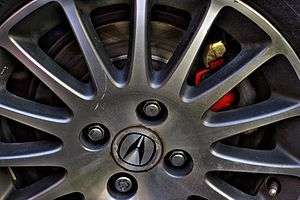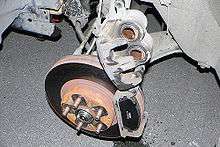Lug nut

A lug nut or wheel nut is a fastener, specifically a nut, used to secure a wheel on a vehicle. Typically, lug nuts are found on automobiles, trucks (lorries), and other large vehicles using rubber tires.
Design
A lug nut is a nut with one rounded or conical (tapered) end, used on steel and most aluminum wheels. A set of lug nuts are typically used to secure a wheel to threaded wheel studs and thereby to a vehicle's axles.

Some designs (BMW, Mercedes-Benz, Saab, Volkswagen) use lug bolts instead of nuts, which screw into a tapped (threaded) hole in the wheel's hub or drum brake or disc. This configuration is commonly known as a bolted joint.
The lug's taper is normally 60 degrees (although 45 is common for wheels designed for racing applications), and is designed to center the wheel accurately on the axle, and to reduce the tendency for the nut to loosen, due to fretting induced precession, as the car is driven. Honda uses a spherical rather than a tapered seat, but the nut performs the same function. Older style (non-ferrous) alloy wheels have a 1/2 to 1 inch cylindrical shank slipping into the wheel to center it and a washer that applies pressure to clamp the wheel to the axle.
Wheel lug nuts may have different shapes. Aftermarket alloy and forged rims often require specific lug nuts to match their mounting holes, so it's often required to get a new set of lug nuts when the rims are changed. There are 4 common lug nut types: "Cone Seat", "Bulge Cone Seat", "Under Hub Cap", and "Spline Drive".
Removal and installation

Lug nuts may be removed using a lug, socket or impact wrench. If the wheel is to be removed then an automotive jack to raise the vehicle and some wheel chocks would be used as well. Wheels that have hubcaps or hub covers need these removed beforehand, typically with a screwdriver,[1] flatbar, or prybar. Lug nuts can be difficult to remove, as they may become frozen to the wheel stud. In such cases a breaker bar or repeated blows from an impact wrench can be used to free them. Alternating between tightening and loosening can free especially stubborn lug nuts.
Lug nuts must be installed in an alternating pattern, commonly referred to as a star pattern.[2] This ensures a uniform distribution of load across the wheel mounting surface. When installing lug nuts, it is recommended to tighten them with a calibrated torque wrench. While a lug, socket or impact wrench may be used to tighten lug nuts the final tightening should be performed by a torque wrench, ensuring an accurate and adequate load is applied. Torque specifications vary by vehicle and wheel type. Both vehicle and wheel manufacturers provide recommended torque values which should be consulted when an installation is done. Failure to abide by the recommended torque value can result in damage to the wheel and brake rotor/drum. Additionally, under tightened lug nuts may come loose with time.
Detecting loose nuts
In order to allow early detection of loose lug nuts, some large vehicles are fitted with loose wheel nut indicators. The indicator spins with the nut, so that it can be detected with a visual inspection.
Anti-theft nuts or bolts
In countries where the theft of alloy wheels is a serious problem, locking nuts (or bolts, as applicable) are available - or already fitted by the vehicle manufacturer - which require a special adaptor ("key") between the nut and the wrench to fit and remove. The key is normally unique to each set of nuts. Only one locking nut per wheel is normally used, so they are sold in sets of four. Most designs can be defeated using a hardened removal tool which uses a left-hand self-cutting thread to grip the locking nut, although more advanced designs have a spinning outer ring to frustrate such techniques. Sometimes the key of these lockable nuts get lost or the internal architecture gets destroyed when a power tool is used. Every lock deserves a solid key that can be easily replaced if misplaced. Lockable lug nuts leave a lot to be desired.
History
Some cars made prior to about 1960 used left-hand and right-hand screw thread for different sides of the vehicle to prevent loosening. It was later realized that the taper seat performed the same function. Modern vehicles use right-hand threads on all wheels.
See also
References
- ↑ "Removing and Installing Wheels". NSX Prime. 1997. Retrieved October 4, 2007.
- ↑ "What Order Do I Tighten My Lug Nuts?". Matthew Wright, About.com. Retrieved April 22, 2010.